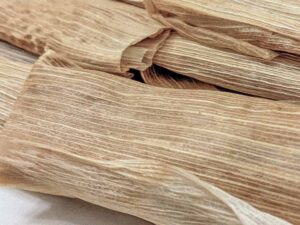Bone Broth

Mrs. April Jaure
Once or twice a week, a stock pot sits on our stove — its contents simmering away for a full day and night. Its aroma fills the house; most of the time I don’t notice the familiar fragrance, but my visitors always seem to. “What smells so good? What’s cooking?” they ask. “Just making bone broth,” I respond. I imagine this is the primary fragrance that has filled countless houses, tents, and huts all over the world throughout the centuries.
In our home, bone broth isn’t usually a meal in itself, but it is the foundation of almost everything my family eats. We always try to have some on hand to use when we make soups or rice, or almost any time water could be used in a dish. Does the sauce need more liquid? I’ll likely add some bone broth.
Bone broth is a superfood that is really easy to make, but for some reason making it has become something of a lost art. Happily, it has been making something of a comeback in the last few years. Previous generations knew how to use every part of the animals they ate and so wasted very little. This practice is not only more respectful of the animal who has given its life to feed us, it is also more beneficial to us who require all the nutrients found in the meat, bones, and connective and organ tissues to build up our own bodies.
When the bones of an animal are simmered in water for an extended period, the nutrients and vitamins that they contain are released into the broth. A broth made from bones plus connective tissues and a little meat and fat is better still, as our bodies’ own joints and connective tissues need these building blocks for themselves. Bone broth contains healthy fats beneficial to our central nervous system and digestive health. It also promotes a healthy gut, which is the foundation of health for the rest of our bodies. If our guts can’t absorb the nutrients our bodies need, all of the body’s other systems can’t perform the tasks they are required to. Many nutritionists and doctors are beginning to understand that gut health — or the lack of it — plays a role in the development of allergies, autoimmune issues, and even issues like brain fog and anxiety. I believe that if a person wants to make one high-impact change to their lifestyle to improve their health, making and consuming bone broth would be it. It provides excellent nutrition and it is very hard to mess up.
I start my stock with whatever bones and vegetables I have on hand. If I have gotten soup bones from the butcher, I will use them. These come from the larger bones of an animal and they typically contain bone marrow, which contains great compounds for our skin, digestive, and joint health. In fact, bone marrow may contain more vital nutrition than the meat itself. Bones also contain gelatin, a great ingredient to repair gut damage or to preserve gut health.
— April
Bone Broth Recipe

What You Need
Ingredients:
• Filtered water
• Soup bones or leftover bones from anything you’ve cooked
• 4 cups of vegetables (onion, celery, mushrooms, garlic, and carrots are my own go-to’s)
• 1-2 Tbsp apple cider vinegar
Materials:
• Stockpot
• Sieve
• 1/2 gallon mason jars to store the stock
What You Do
1. Put your soup bones or other leftover bones in the stock pot, cover with water, and put in a little splash (1 – 2 Tablespoons) of apple cider vinegar. The vinegar will help extract the minerals from the bones, making a more nutritionally powerful broth. Roasting the bones ahead of time will add flavor to the broth, but if you want to keep it simple, just throw them in the pot raw. If I don’t have soup bones from the butcher, I use the leftover bones from my family’s meals. Whatever meat my family buys, we try to buy it with the bones in, so they can be frozen and then taken out to be used to make broth as needed.
2. Let sit for 30 minutes.
3. Add more water to the pot and bring to a boil. If needed, skim the scum off the top and discard.
4. Once boiling, cover and turn down to a simmer. Simmer for about 24 hours. Some recommend 12 hours, but to get the most nutrition from the bones, I recommend simmering from 24 to 48 hours. Add more water as necessary. I like to keep my stock pot relatively full.
5. A couple of hours before your broth is finished, add the vegetables. Adding these toward the end will instill a fresher flavor.
6. Turn off the burner and let cool slightly.
7. Strain broth using a fine mesh sieve. If you are using soup bones, be sure to scrape the marrow out of the bones. This can be added to the broth or just eaten on its own. My own children like to eat marrow spread on bread like butter. If the bones are roasted ahead of time, the marrow can be removed from the bone immediately after roasting.
8. Discard bones and vegetables and store broth in half-gallon containers in the refrigerator. Some say that broth can be kept in the refrigerator for a week, but the Weston Price Foundation says that as long as the broth contains at least half an inch of fat that rises to the top, that this creates a seal preventing air from getting to the broth and preserving it in the refrigerator for six months with no canning required. Once that seal is broken, however, the broth should be used within a week. If you have a smaller family and might not use a half a gallon of broth at a time (or within a week), you may wish to store in smaller jars.
Notes:
An alternative way to make bone broth is to start with a whole chicken. This is convenient if you want blanched chicken meat to use in a dish. Put the chicken in the pot and cover with water. Boil the chicken for an hour (it will easily fall apart when done), and remove the chicken and place on a plate to let cool until it can be handled. Once cool enough, remove the meat and then place the carcass back in the pot and simmer for a day. If you begin your broth with a whole chicken, one chicken is sufficient, if you begin with just a chicken carcass, I find that using one makes the broth too diluted, so I use two chicken carcasses.
While I typically keep bones of the same kind of animal together when I make broth (i.e. use only chicken bones when making chicken broth), I have been known to throw a random pork bone in along with the beef bones just to use it up, and everything worked out just fine.
If you are short on time, you can skip the 30 minutes of the bones sitting in the water with the apple cider vinegar. Just put bones, vinegar, and apple cider vinegar in the pot and heat immediately.
Also, some people put their vegetables in the pot right away. I did this for years, but I think the flavor improves by adding the vegetables partway through the process. But the broth will not be ruined by putting it all in the pot at the beginning. At times we have even skipped the vegetables altogether and just used meat and water.
I usually keep the broth plain. I don’t add herbs or salt to the broth, as I prefer to have a versatile broth that I can use in a variety of ways. If I am cooking rice, I just use the plain broth; if I am making soup, then I will add the herbs of my choice to the soup.
Broth is a great way to use up vegetable scraps or vegetables a little past peak. These all can go in the pot for added nutrition. Some people avoid broccoli, cauliflower, and turnips as they say these are too strong and add bitterness to the stock. Adding starchy vegetables like potatoes and squash will make the stock cloudy. Squash peels, however, can be a great addition. Onion peels can also go in the broth but they will color it (as will beets) so for this reason many people avoid adding these. Leafy items are usually best in small amounts and added near the end, and some leaves (like cilantro) may be too strong.
Although chicken heads and feet can be difficult to find, if you have them, they add excellent nutrition and much-needed gelatin for our bodies. Likewise, organ meats are extremely nutritious, but many people dislike their taste and texture. If this is you, adding organ meats to broth can be an easy way to get their nutrition without having to eat them outright.
You might also want to switch it up and make a short-simmered broth rather than bone broth sometimes. A short-simmered broth is typically cooked for two or three hours, whereas a bone broth is cooked for 12 or more hours. A short-simmered broth has a different amino acid profile than a long-simmered one, and so varying the broth can be beneficial.
As you can see, it is very difficult to mess up broth. The most flavorful broth will begin with roasted bones and have vegetables added part way through the cooking process. Allowing it to rest with a little apple cider vinegar will help withdraw more nutrients, but you can break all these rules and still have a tasty, nutrient-dense broth to use in your cooking. Of course, you can also drink it just as is, which is what every adult and child in my home gets when feeling under the weather, probably just like generations of traditional cooks before me.



















